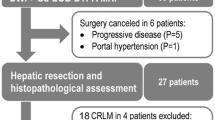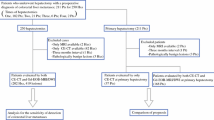Abstract
Objectives
To investigate the diagnostic performance of gadoxetic acid-enhanced MRI including diffusion-weighted imaging (DWI) for the detection of colorectal liver metastases (CRLMs) after neoadjuvant chemotherapy (NAC).
Methods
Our study population comprised 77 patients with 140 CRLMs who underwent gadoxetic acid-enhanced MRI within 1 month prior to surgery: group A (without NAC, n = 38) and group B (with NAC, n = 39). Two radiologists independently assessed all MR images and graded their diagnostic confidence for CRLM on a 5-point scale. Diagnostic accuracy, sensitivity and positive predictive values (PPV) were calculated and compared between the two groups.
Results
Diagnostic accuracy of gadoxetic acid-enhanced MRI in group B was slightly lower than in group A, but a statistically significant difference was not observed (observer 1: A z, 0.926 in group A, 0.905 in group B; observer 2: A z, 0.944 in group A, 0.885 in group B; p > 0.05). Sensitivity and PPV of group B were comparable to those of group A (observer 1: sensitivity = 93.5 % vs. 93.6 %, PPV = 95.1 % vs. 86.9 %; observer 2: sensitivity = 96.8 % vs. 91.0 %; PPV = 90.0 % vs. 89.7 %; all p > 0.05).
Conclusions
Gadoxetic acid-enhanced MRI including DWI provided good diagnostic performance with high sensitivity (>90 %) for the detection of CRLMs, regardless of the influence of NAC.
Key Points
• Gadoxetic acid-enhanced MRI including DWI shows high sensitivity for CRLMs.
• Chemotherapy does not influence the diagnostic performance of liver MRI for CRLMs.
• Gadoxetic acid-enhanced MRI can be used for evaluation of CRLMs after NAC.



Similar content being viewed by others
Abbreviations
- CRLM:
-
Colorectal liver metastases
- DWI:
-
Diffusion-weighted imaging
- HBP:
-
Hepatobiliary phase
- NAC:
-
Neoadjuvant chemotherapy
- PPV:
-
Positive predictive value
References
Jemal A, Siegel R, Xu J, Ward E (2010) Cancer statistics, 2010. CA Cancer J Clin 60:277–300
Manfredi S, Lepage C, Hatem C, Coatmeur O, Faivre J, Bouvier AM (2006) Epidemiology and management of liver metastases from colorectal cancer. Ann Surg 244:254–259
Leonard GD, Brenner B, Kemeny NE (2005) Neoadjuvant chemotherapy before liver resection for patients with unresectable liver metastases from colorectal carcinoma. J Clin Oncol 23:2038–2048
Abdalla EK, Adam R, Bilchik AJ, Jaeck D, Vauthey JN, Mahvi D (2006) Improving resectability of hepatic colorectal metastases: expert consensus statement. Ann Surg Oncol 13:1271–1280
Pawlik TM, Choti MA (2007) Surgical therapy for colorectal metastases to the liver. J Gastrointest Surg 11:1057–1077
Adam R, Delvart V, Pascal G et al (2004) Rescue surgery for unresectable colorectal liver metastases downstaged by chemotherapy: a model to predict long-term survival. Ann Surg 240:644–657, discussion 657–648
Adam R, Pascal G, Castaing D et al (2004) Tumor progression while on chemotherapy: a contraindication to liver resection for multiple colorectal metastases? Ann Surg 240:1052–1061, discussion 1061–1054
Niekel MC, Bipat S, Stoker J (2010) Diagnostic imaging of colorectal liver metastases with CT, MR imaging, FDG PET, and/or FDG PET/CT: a meta-analysis of prospective studies including patients who have not previously undergone treatment. Radiology 257:674–684
Robinson PJ (2009) The effects of cancer chemotherapy on liver imaging. Eur Radiol 19:1752–1762
Pilgrim CH, Thomson BN, Banting S, Phillips WA, Michael M (2012) The developing clinical problem of chemotherapy-induced hepatic injury. ANZ J Surg 82:23–29
Carnaghi C, Tronconi MC, Rimassa L et al (2007) Utility of 18 F-FDG PET and contrast-enhanced CT scan in the assessment of residual liver metastasis from colorectal cancer following adjuvant chemotherapy. Nucl Med Rev Cent East Eur 10:12–15
Angliviel B, Benoist S, Penna C et al (2009) Impact of chemotherapy on the accuracy of computed tomography scan for the evaluation of colorectal liver metastases. Ann Surg Oncol 16:1247–1253
Spatz J, Holl G, Sciuk J, Anthuber M, Arnholdt HM, Markl B (2011) Neoadjuvant chemotherapy affects staging of colorectal liver metastasis–a comparison of PET, CT and intraoperative ultrasound. Int J Colorectal Dis 26:165–171
van Kessel CS, van Leeuwen MS, van den Bosch MA et al (2011) Accuracy of multislice liver CT and MRI for preoperative assessment of colorectal liver metastases after neoadjuvant chemotherapy. Dig Surg 28:36–43
van Kessel CS, Buckens CF, van den Bosch MA, van Leeuwen MS, van Hillegersberg R, Verkooijen HM (2012) Preoperative imaging of colorectal liver metastases after neoadjuvant chemotherapy: a meta-analysis. Ann Surg Oncol 19:2805–2813
Seo HJ, Kim MJ, Lee JD, Chung WS, Kim YE (2011) Gadoxetate disodium-enhanced magnetic resonance imaging versus contrast-enhanced 18 F-fluorodeoxyglucose positron emission tomography/computed tomography for the detection of colorectal liver metastases. Invest Radiol 46:548–555
Chen L, Zhang J, Zhang L et al (2012) Meta-analysis of gadoxetic acid disodium (Gd-EOB-DTPA)-enhanced magnetic resonance imaging for the detection of liver metastases. PLoS One 7:e48681
Lafaro KJ, Roumanis P, Demirjian AN, Lall C, Imagawa DK (2013) Gd-EOB-DTPA-enhanced MRI for detection of liver metastases from colorectal cancer: a surgeon’s perspective! Int J Hepatol 2013:572307
Chung WS, Kim MJ, Chung YE et al (2011) Comparison of gadoxetic acid-enhanced dynamic imaging and diffusion-weighted imaging for the preoperative evaluation of colorectal liver metastases. J Magn Reson Imaging 34:345–353
Koh DM, Collins DJ, Wallace T, Chau I, Riddell AM (2012) Combining diffusion-weighted MRI with Gd-EOB-DTPA-enhanced MRI improves the detection of colorectal liver metastases. Br J Radiol 85:980–989
Kim YK, Lee MW, Lee WJ et al (2012) Diagnostic accuracy and sensitivity of diffusion-weighted and of gadoxetic acid-enhanced 3-T MR imaging alone or in combination in the detection of small liver metastasis (</= 1.5 cm in diameter). Invest Radiol 47:159–166
Donati OF, Fischer MA, Chuck N, Hunziker R, Weishaupt D, Reiner CS (2013) Accuracy and confidence of Gd-EOB-DTPA enhanced MRI and diffusion-weighted imaging alone and in combination for the diagnosis of liver metastases. Eur J Radiol 82:822–828
Macera A, Lario C, Petracchini M et al (2013) Staging of colorectal liver metastases after preoperative chemotherapy. Diffusion-weighted imaging in combination with Gd-EOB-DTPA MRI sequences increases sensitivity and diagnostic accuracy. Eur Radiol 23:739–747
Ba-Ssalamah A, Uffmann M, Saini S, Bastati N, Herold C, Schima W (2009) Clinical value of MRI liver-specific contrast agents: a tailored examination for a confident non-invasive diagnosis of focal liver lesions. Eur Radiol 19:342–357
Chakraborty DP, Winter LH (1990) Free-response methodology: alternate analysis and a new observer-performance experiment. Radiology 174:873–881
Metz CE (1986) ROC methodology in radiologic imaging. Invest Radiol 21:720–733
Shin NY, Kim MJ, Lim JS et al (2012) Accuracy of gadoxetic acid-enhanced magnetic resonance imaging for the diagnosis of sinusoidal obstruction syndrome in patients with chemotherapy-treated colorectal liver metastases. Eur Radiol 22:864–871
Lubezky N, Metser U, Geva R et al (2007) The role and limitations of 18-fluoro-2-deoxy-D-glucose positron emission tomography (FDG-PET) scan and computerized tomography (CT) in restaging patients with hepatic colorectal metastases following neoadjuvant chemotherapy: comparison with operative and pathological findings. J Gastrointest Surg 11:472–478
Jeong HT, Kim MJ, Park MS et al (2012) Detection of liver metastases using gadoxetic-enhanced dynamic and 10- and 20-minute delayed phase MR imaging. J Magn Reson Imaging 35:635–643
Lowenthal D, Zeile M, Lim WY et al (2011) Detection and characterisation of focal liver lesions in colorectal carcinoma patients: comparison of diffusion-weighted and Gd-EOB-DTPA enhanced MR imaging. Eur Radiol 21:832–840
Han NY, Park BJ, Sung DJ et al (2014) Chemotherapy-induced focal hepatopathy in patients with gastrointestinal malignancy: gadoxetic acid-enhanced and diffusion-weighted MR imaging with clinical-pathologic correlation. Radiology 271:416–425
Tamada T, Ito K, Ueki A et al (2012) Peripheral low intensity sign in hepatic hemangioma: diagnostic pitfall in hepatobiliary phase of Gd-EOB-DTPA-enhanced MRI of the liver. J Magn Reson Imaging 35:852–858
Acknowledgments
The scientific guarantor of this publication is Prof. Jeong Min Lee. The authors of this manuscript declare no relationships with any companies whose products or services may be related to the subject matter of the article. This work was supported by Research Settlement Fund for the new faculty of SNU (No 800-20140181). The Medical Research Collaboration Center (Seoul National University Hospital) kindly provided statistical advice for this manuscript. Institutional review board approval was obtained. Written informed consent was waived by the institutional review board. Methodology: retrospective, case-control study, performed at one institution.
Author information
Authors and Affiliations
Corresponding author
Rights and permissions
About this article
Cite this article
Yu, M.H., Lee, J.M., Hur, B.Y. et al. Gadoxetic acid-enhanced MRI and diffusion-weighted imaging for the detection of colorectal liver metastases after neoadjuvant chemotherapy. Eur Radiol 25, 2428–2436 (2015). https://doi.org/10.1007/s00330-015-3615-5
Received:
Revised:
Accepted:
Published:
Issue Date:
DOI: https://doi.org/10.1007/s00330-015-3615-5




